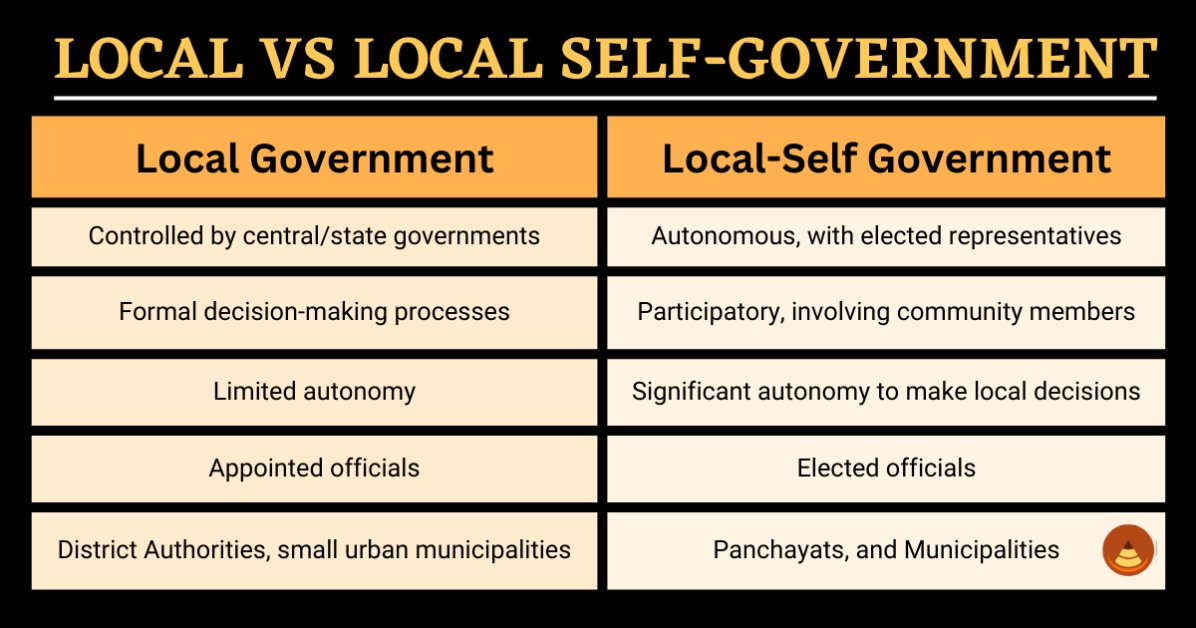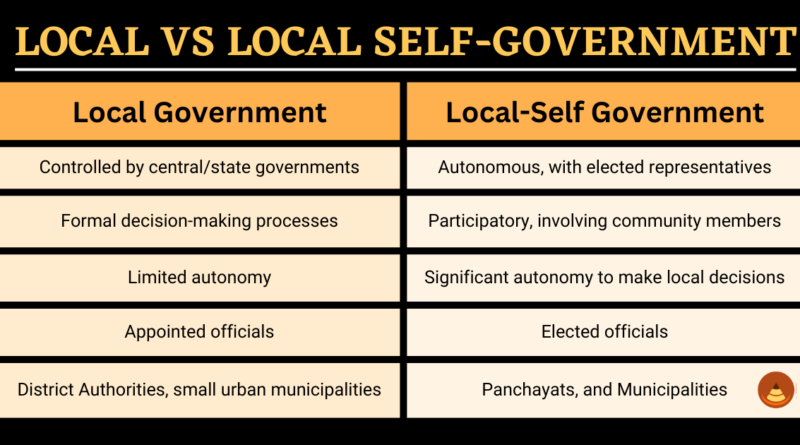Difference Between Local Government and Local Self-Government
In India, the terms Local Government and Local Self-Government often create confusion. While both refer to governance at the local level, they differ significantly in terms of autonomy, decision-making processes, and the role of the local community in governance.
Table of Contents
What is Local Government?
Local Government refers to bodies formed by the central or state government to manage administrative functions at the local level. These bodies have limited autonomy and operate within the framework set by higher-level authorities. Officials in Local Governments are often appointed by the state or central government and are accountable to these higher bodies.
Examples of Local Government Bodies
1. District Authorities: In each district, the District Magistrate or Collector, appointed by the state government, oversees law and order, revenue collection, and administrative duties. For example, the District Magistrate in a district such as Patna would be responsible for coordinating government activities, handling natural disasters, or implementing state directives.
2. Urban Local Bodies (Municipalities): Smaller towns and cities have municipalities appointed or overseen by state governments. For instance, the Municipality of Varanasi manages basic urban services but still operates under state laws and instructions.
What is Local Self-Government?
Local Self-Government refers to local governance bodies that are elected by the people of the area. These bodies are granted autonomy to make decisions related to local governance and development. The goal of Local Self-Government is to ensure that decisions affecting the community are made by those who are directly impacted by them.
These bodies handle governance in areas such as education, health, infrastructure, sanitation, and social welfare, and they often work with a high level of community participation.
Examples of Local Self-Government Bodies
1. Panchayats (Rural Local Self-Government): The Gram Panchayat in a village is an example of local self-governance. Elected members of the Panchayat are responsible for decisions regarding rural development, such as:
- Improving infrastructure like building roads and bridges in villages.
- Managing sanitation and waste management systems.
- Providing access to basic healthcare by setting up rural health centers.
- Promoting education and organizing adult literacy programs in rural areas.
For example, the Gram Panchayat in Sarpanch-led rural areas like Sikkim takes decisions on maintaining the cleanliness of the village and implementing government welfare schemes.
2. Municipalities and Municipal Corporations (Urban Local Self-Government): These bodies manage urban affairs such as sanitation, urban planning, water supply, and health services in cities and towns. Municipalities and Municipal Corporations like the Mumbai Municipal Corporation or the Delhi Municipal Corporation are examples of urban local self-government. They are responsible for:
- Urban infrastructure such as maintaining roads, parks, and sewage systems.
- Public health services like controlling epidemics and sanitation.
- Urban planning, including zoning areas for commercial, residential, and industrial purposes.
- Providing local amenities, including public transport and electricity supply.
For example, Mumbai Municipal Corporation handles the construction and maintenance of the city’s roads, street lighting, waste management, and public health initiatives. Similarly, the Delhi Municipal Corporation ensures sanitation and safety in the national capital.
Key Differences Between Local Government and Local Self-Government
| Feature | Local Government | Local Self-Government |
|---|---|---|
| Control | Controlled by central/state governments | Autonomous, with elected representatives |
| Decision-Making | Formal decision-making processes | Participatory, involving community members |
| Autonomy | Limited autonomy | Significant autonomy to make local decisions |
| Authority | Appointed officials, accountable to higher authorities | Elected officials, accountable to local community |
| Examples | District Authorities, small urban municipalities | Panchayats, Municipal Corporations, and Municipalities |

Constitutional Provisions
Panchayats (Local Self-Government): The 73rd Constitutional Amendment (1992) specifically provides for the formation of Panchayats at the village, intermediate, and district levels, ensuring that local people can participate in governance. The amendment outlines the powers and responsibilities of Panchayats, making them an essential part of the decentralization process in India.
Municipalities and Municipal Corporations (Local Self-Government): Similarly, the 74th Constitutional Amendment (1992) mandates the formation of Urban Local Bodies, including Municipalities and Municipal Corporations. These bodies are responsible for urban governance, and their powers are enshrined in the Constitution.
Local Governments: The Constitution also provides provisions for the establishment of various local government bodies through legislative acts passed by the central or state governments.
Conclusion
In summary, Local Government is controlled by central or state authorities with limited autonomy, while Local Self-Government involves elected bodies with greater decision-making power and autonomy. Local Self-Government, like Panchayats and Municipalities, plays a crucial role in empowering local communities, promoting democracy, and addressing their specific needs.
Both systems are essential for effective local governance, but Local Self-Government ensures that local citizens have a direct say in their community’s development and management.

